One of the common arguments that anti-vaxxers use to support their cause is that as vaccination rates have increased so have autism diagnoses. People will even trot out pretty graphs showing a steep increase in autism rates following the introduction of the MMR vaccine. There is no medical evidence that vaccinations lead to autism as I discussed in a previous post. Making the leap from correlation to causation is fairly common, even among science majors, though. One of the first activities I do in my Neurophysiology class is a Correlation vs. Causation assignment (full activity: NeuroscienceSociety1_CorrelationVSCausation_2). I have students describe what conclusions they can draw from the graph below. I then have them design an experiment that would actually test whether organic food sales/consumption causes autism.
Tag Archives: Science Outreach
Talk to Your Friends and Family About Science: Ebola Edition
This weekend my grandmother asked me if I had heard that two American aid workers with Ebola were being treated at Emory University. To be fair to my grandmother, I didn’t wait to see if she was worried about Ebola spreading in the US or just brought it up since she knew I did my postdoc at Emory. Instead I immediately replied, that yes I had heard they had been taken to Emory and that I was sure the doctors and nurses at Emory were in a very good position to treat them safely. I also told her that Ebola is relatively difficult to catch as you have to be exposed to bodily fluids from an infected patient.
This conversation illustrates a really important science advocacy role that we should all be playing: helping to inform the public (and especially those closest to us) about science and how to find reliable sources of information. There is a lot of misinformation about Ebola swirling around and we need to find some way to make sure the real science is heard over all the fear mongering.
Here are some great resources on Ebola to share with your family and friends:
“Please don’t panic about Ebola, here’s what you need to know” by Danielle N. Lee — Short and very accessible article appropriate for everyone.
“Everything you know about Ebola is Wrong” by Tara C. Smith — 5 Ebola myths debunked. Other posts on the author’s Aetiology site are also quite informative and go a bit more in depth about some of the background science.
Of course, communicating science isn’t always easy…
Image from Twitter user @emmkaff

